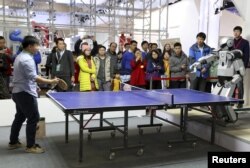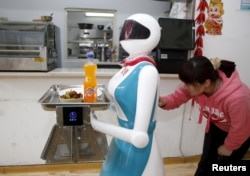Dozens of investors and knowledge collaborators recently visited China from the U.S. and Europe to join in what is being seen as a robotic revolution. Though China has emerged as the biggest market for industrial robots, what is attracting angel investors is the Chinese ability to fabricate and produce at low-cost for the international market.
China biggest supplier of electronic goods
"There is also a lot of innovation going on in China but I think the bigger opportunity is to use China to make your idea become real," Benjamin Joffe, a partner with Hax, an investing company, told VOA at the recent Global Mobile Internet Conference in Beijing. Most of the investors and start-ups coming to China are focusing on markets in the U.S. and Europe, he said.
China has already established a vast network of production and supply chains and associated skills to become the biggest supplier of electronic goods. "For robotics, the advantage is to prototype faster, to be able to produce things at not just lower cost, but also high-tech at any scale--from small scale to very large scale," Joffe said.
Future robotics growth in China
The International Federation of Robotics recently predicted that China will have more industrial robots operating in its factories by 2017 than any other country. Other analysts have said Japan will lose its place as the biggest user of industrial robots next year.
The Chinese robot market, estimated at $9.5 billion, is one of the world's biggest. About one fourth of the 240,000 industrial robots sold worldwide is made in China, according to IFR estimates.
But China also has the biggest potential for further growth because of the low coverage of robots compared to its sprawling industrial zones. There are 30 robots per 10,000 workers in China's manufacturing units compared to a high level of 437 in South Korea, 323 in Japan, 282 in Germany and 152 in the United States, IFR said.
As with most other goods, Chinese robot manufacturers are also trying to take on international giants on the strength of low pricing. For instance,E-Deodar, a subsidiary of Shanghai-based Ningbo Techmation is producing robots for 20-30 percent less compared to three of the world's biggest players, ABB, Germany’s Kuka or Japan’s Kawasaki.
The main reason why Chinese businesses are opting for gigantic and highly efficient robotic arms is to recover some of the lost export markets. Experts cite three important reasons behind the sharp reduction in Chinese electronic and heavy machine exports in recent years. They are the economic slowdown in western markets, complaints about quality of some Chinese products and the rising cost of labor in China.
Cheaper labor, higher quality
Both Chinese industry and government are trying to overcome the problem of high cost and inadequate supply of skilled labor by using giant and highly efficient robotic arms in the supply lines. The high level of precision of these electronic arms also helps raise quality standards and leaves behind very few production defects, if any at all.
"Labor costs have increased hugely. So, we expect the market to become very large in the coming years. There is also a great need for technological solutions to problems concerning production and quality, which our company provides," said Li Lijun, president of Ningbo Cixing Robotics Co.
Li said shoe making factories across Chinese provinces of Zhejiang and Fujian are gradually adopting robotic systems to both replace workers and enhance both quality and production. Li says this is a change because he said many still believe that the use of robots is limited to industries engaged in producing high-end electronics and complex machines.
“In shoe making, [an] assembly line may have about 26 workers. A robotic system can run that line with just two workers. Two workers are still necessary because human beings can perform certain complex and intricate tasks better but requirement of such specialized workers is much less," Li explained.
But lowering costs continues to remain the biggest challenge, even for manufacturers in China with their long tradition of cutting corners. At a basic level, a robotic system that can replace 20 to 30 workers can cost upwards of $100,000. But robot makers say the costs can come down to about one-third as the market expands and they are able to scale up their production.
Beyond factory work
Robots are also of interest to a lot of Chinese beyond just factory production.
One restaurant, which introduced "robot waiters" to replace serving staff, found that the electronic imitators of humans did not serve the purpose. The robots had to be replaced with real workers. Undeterred, a jewelry shop in Guangzhou has introduced eight robot servants to support the sales staff.
The China International Robot show in Shanghai recently displayed a robot bearing resemblance to Japanese Prime Minister Shinzo Abe repeatedly making apologetic bows. This was seen as a reference to China's off-repeated demand that Abe sincerely apologize for the atrocities committed by Japanese soldiers on Chinese citizens, including women in Nanjing, during World War II.










